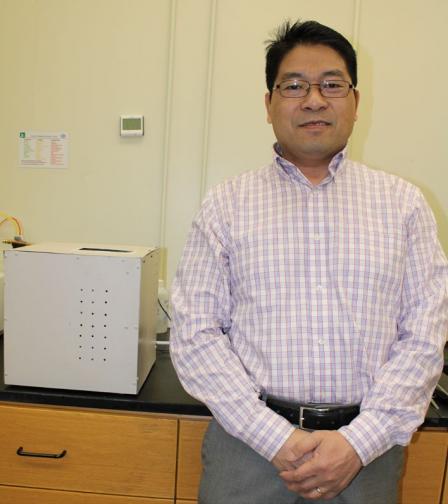Supporting Innovations to Reduce Nitrogen Pollution from Septic Systems
Published May 19, 2020
 Dr. Qingzhi Zhu of Stony Brook University and the New York State Center for Clean Water Technology in Stony Brook, N.Y.Septic systems are common in coastal marine communities on the East Coast of the United States. Septic systems consist of subsurface wastewater treatment structure and use a combination of natural processes and technology to treat residential sanitary waste and greywater from bathrooms, kitchen drains, and laundry. Partially cleaned wastewater is discharged from septic tanks into drain fields, where the water is further treated through biological processes as it travels through gravel, soil, and can eventually reach groundwater. Groundwater linkages with surface waters can then transport any nutrients and contaminants that are present in discharge directly into coastal waters.
Dr. Qingzhi Zhu of Stony Brook University and the New York State Center for Clean Water Technology in Stony Brook, N.Y.Septic systems are common in coastal marine communities on the East Coast of the United States. Septic systems consist of subsurface wastewater treatment structure and use a combination of natural processes and technology to treat residential sanitary waste and greywater from bathrooms, kitchen drains, and laundry. Partially cleaned wastewater is discharged from septic tanks into drain fields, where the water is further treated through biological processes as it travels through gravel, soil, and can eventually reach groundwater. Groundwater linkages with surface waters can then transport any nutrients and contaminants that are present in discharge directly into coastal waters.
In many instances, conventional septic systems are not designed to remove nitrogen to concentrations protective of water quality and the coastal environment. As a result, in some coastal communities, excess nitrogen levels have become a problem leading to eutrophication (too many nutrients in a water body), harmful algal blooms, fish kills, and beach closures. In places like Suffolk County, NY, which has over 360,000 conventional septic systems and cesspools, excess nitrogen can be a serious issue.
Innovative or advanced onsite wastewater treatment systems (advanced septic systems) that are designed to reduce nitrogen discharges by 50 percent or more can be a significant part of the solution. EPA estimates that there are at least 2.6 million septic systems located in nitrogen-sensitive watersheds that are good candidates to be replaced by advanced septic systems.
Large-scale adoption and investment in advanced septic systems could be enhanced by using a low-cost in-situ nitrogen sensor to monitor system performance. Regulators and other stakeholders want to know if advanced septic systems are working as intended. Automated sensors can provide real time knowledge and eliminate the need for manual sample collection. There are some nitrogen sensors available currently, but their high cost, need for frequent re-calibration and, at times, their size, can prevent them from being used in advanced septic systems.
In 2017, EPA and The Nature Conservancy (TNC) launched the Advanced Septic System Nitrogen Sensor Challenge. The Challenge focused on the development of a nitrogen sensor that could be installed with advanced septic systems. In 2019, three teams competed to test nitrate, nitrite, and ammonium sensors at the Massachusetts Alternative Septic Test Center.
The three sensors underwent rigorous testing in both real and artificial septic tank effluents. The testing also simulated a system failure to ensure functionality in extreme scenarios. Readings were taken from the sensors every hour, and samples were collected for lab testing to determine the true values of nitrate, nitrite and ammonium in the effluent. One sensor, developed by Dr. Qingzhi Zhu of Stony Brook University, passed the test with outstanding results.
“This is why EPA created this challenge,” says Dr. Zhu. “Nitrogen load is a big issue in coastal areas, and a sensor can tell us what’s going on inside septic systems, how well the tanks are removing nitrogen, and provide real-time results that stakeholders can use to evaluate the health of coastal waterways.”
This real-time knowledge can allow for quick action to be taken in the event of a septic system malfunction. If ultimately proven reliable and economically practical to install then these sensors could provide homeowners and local governments with the reassurance that septic systems are operating properly and even encourage investment in advanced septic systems, resulting in lower nitrogen pollution levels.
More Information
-
Webinar with the Winner of the EPA Advanced Septic System Nitrogen Sensor Challenge on May 27, 2020 from 2:00 PM to 3:30 PM EST, featuring Dr. Zhu, EPA, and the Director of MASSTC
- Long Island Scientist Wins EPA Advanced Septic System Nitrogen Sensor Challenge
Source: Winter T.C., Harvey J.W., Franke L.O. and Alley W.M. 1998. Ground Water and Surface Water A Single Resource.Exit Denver, CO. U.S. Geological Survey.
